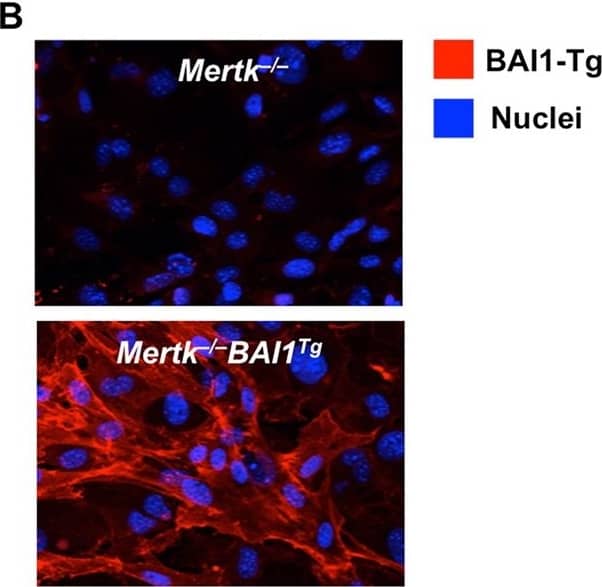Human BAI1 Antibody
R&D Systems, part of Bio-Techne | Catalog # AF4969

Key Product Details
Species Reactivity
Validated:
Human
Cited:
Mouse
Applications
Validated:
Neutralization
Cited:
Bioassay
Label
Unconjugated
Antibody Source
Polyclonal Sheep IgG
Product Specifications
Immunogen
Chinese hamster ovary cell line CHO-derived recombinant human BAI1
Ala31-Thr879
Accession # O14514
Ala31-Thr879
Accession # O14514
Specificity
Detects human BAI1 in direct ELISAs. In direct ELISAs, less than 2% cross-reactivity with recombinant human BAI3 is observed.
Clonality
Polyclonal
Host
Sheep
Isotype
IgG
Endotoxin Level
<0.10 EU per 1 μg of the antibody by the LAL method.
Scientific Data Images for Human BAI1 Antibody
Detection of Mouse BAI1 by Immunocytochemistry/Immunofluorescence
Bai1Tg reduces accumulation of apoptotic corpses in Mertk−/− mice post-torsion. (A) Sertoli cell expression of Bai1, BAI1 signaling pathway genes, and Mertk were analyzed by quantitative RT-PCR. Sertoli cells were isolated from Mertk+/+ (n = 4) and Mertk−/− (n = 2) mice and were cultured for 3 days to expand them prior to RNA isolation. Error bars are standard error of mean (SEM). (B) Representative images of isolated Sertoli cells from Mertk−/− and Mertk−/−Bai1Tg mice were stained for BAI1 to confirm surface expression of the Bai1Tg. (C) Mice (8–12 weeks-old) underwent testicular torsion surgery to induce ischemic injury. Testicular cross sections from sham and torsion testes were stained for cleaved caspase 3 (CC3) (black arrowheads). Images are of representative tubule cross sections from matched sham and torsion testes. (D) The number of CC3 positive cells per tubule cross section was determined by analyzing the entire testicular cross section. Each mouse is represented by individual data points within the bars. Mertk+/+ (n = 5) Mertk−/− (n = 8) Mertk−/−Bai1Tg (n = 9). Error bars represent SEM. Statistical analysis was performed with a Wilcoxon rank-sum test. *p < 0.05, ***p < 0.001. Image collected and cropped by CiteAb from the following publication (https://www.nature.com/articles/s41598-017-15191-1), licensed under a CC-BY license. Not internally tested by R&D Systems.Applications for Human BAI1 Antibody
Application
Recommended Usage
Neutralization
Measured by its ability to neutralize the the enhancemment of adhesion of BCE C/D1b bovine cornea derived endothelial cells induced by BAI-1. The Neutralization Dose (ND50) is typically 2-8 µg/mL in the presence of 0.5 µg/mL Recombinant Human BAI-1.
Formulation, Preparation, and Storage
Purification
Antigen Affinity-purified
Reconstitution
Reconstitute at 0.2 mg/mL in sterile PBS. For liquid material, refer to CoA for concentration.
Formulation
Lyophilized from a 0.2 μm filtered solution in PBS with Trehalose. *Small pack size (SP) is supplied either lyophilized or as a 0.2 µm filtered solution in PBS.
Shipping
Lyophilized product is shipped at ambient temperature. Liquid small pack size (-SP) is shipped with polar packs. Upon receipt, store immediately at the temperature recommended below.
Stability & Storage
Use a manual defrost freezer and avoid repeated freeze-thaw cycles.
- 12 months from date of receipt, -20 to -70 °C as supplied.
- 1 month, 2 to 8 °C under sterile conditions after reconstitution.
- 6 months, -20 to -70 °C under sterile conditions after reconstitution.
Background: BAI1
References
- Nishimori, H. et al. (1997) Oncogene 15:2145.
- Koh, J.T. et al. (2001) Brain Res. Mol. Brain Res. 87:223.
- Mori, K. et al. (2002) Neurosci. Res. 43:69.
- Kaur, B. et al. (2003) Am. J. Pathol. 162:19.
- Park, D. et al. (2007) Nature 450:430.
- Duda, D.G. et al. (2002) Br. J. Cancer 86:490.
- Lee, J.H. et al. (2001) Int. J. Oncol. 18:355.
- Fukushima, Y. et al. (1998) Int. J. Oncol. 13:967.
- Kaur, B. et al. (2005) Oncogene 24:3632.
- Koh, J.T. et al. (2004) Exp. Cell Res. 294:172.
- Kaur, B. et al. (2009) Cancer Res. 69:1212.
- Kang, X. et al. (2006) Cancer Gene Ther. 13:385.
- Hatanaka, H. et al. (2000) Int. J. Mol. Med. 5:181.
Long Name
Brain-specific Angiogenesis Inhibitor 1
Alternate Names
brain-specific angiogenesis inhibitor 1, FLJ41988, GDAIF
Gene Symbol
ADGRB1
UniProt
Additional BAI1 Products
Product Documents for Human BAI1 Antibody
Product Specific Notices for Human BAI1 Antibody
For research use only
